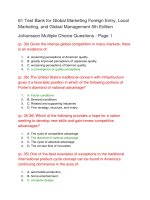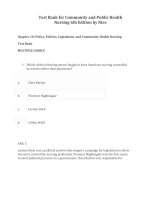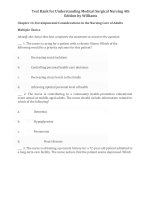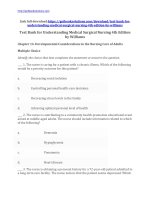Test bank for community public health nursing promoting the health of populations 4th edition by nies
Bạn đang xem bản rút gọn của tài liệu. Xem và tải ngay bản đầy đủ của tài liệu tại đây (49.9 KB, 6 trang )
buy this full document at
Nies: Community/Public Health Nursing, 4th Edition
Test Bank
Chapter 1: Health: A Community View
MULTIPLE CHOICE
1. The approximate percentage of each health care dollar spent on public health services is
a. 3%
b. 10%
c. 25%
d. 50%
ANS: A
PTS:
1
REF: Pages 3
2. Most money spent on health care in the United States goes for
a. Hospital care
b. Physician services
c. Preventive care
d. Public health activities
ANS: A
PTS:
1
REF: Pages 2
3. It is predicted that in the near future the number of community health nurses will
a. Decrease dramatically
b. Decrease slightly
c. Increase substantially
d. Remain the same
ANS: C
PTS:
1
REF: Pages 3
4. It is predicted that within the next decade the number of nurses working in hospitals will
a. Decrease dramatically
b. Decrease significantly
c. Increase substantially
d. Remain the same
ANS: B
PTS:
1
REF: Pages 3
5. An important principle that defines public health is its reliance on which of the following
models?
a. Civil justice—entitlement of people to protection from harm
b. Democratic justice—entitlement of people to rights determined by the majority of
the populous
c. Market justice—entitlement of people to only what they earn
d. Social justice—entitlement of people to the basic necessities for life
buy this full document at
Full file at />ANS: D
PTS:
1
REF: Pages 3
6. Over-investment in technology and curative medical services as found within the U.S. health
care delivery system is illustrative of which of these models of justice?
a. Civil justice
b. Democratic justice
c. Economic justice
d. Market justice
e. Social justice
ANS: D
PTS:
1
REF: Pages 3
7. The three primary functions of public health have been identified as all of the following except
a. Assessment
b. Assurance
c. Education
d. Policy development
ANS: C
PTS:
1
REF: Pages 7 | Box 1-1
8. Essential elements of public health include all of the following except
a. Environmental sanitation
b. Control of communicable disease
c. Education of the individual in personal hygiene
d. Organization of health care services for early diagnosis and prevention of disease
e. Working with private agencies, such as American Heart Association and Red
Cross, to raise money to improve access to care
ANS: E
PTS:
1
REF: Pages 5
9. Public health services exist on federal, state, and local levels. Federal-level public health services
include
a. Advisory and supportive roles
b. Direct protective services such as clean food and water and sanitation
c. Operating hospitals for indigent persons
d. Personal health services such as immunization, family planning, or care for
persons with STDs
ANS: A
PTS:
1
REF: Pages 6-7
Sarah Simms is a nurse at Steven Spielberg High School. Her activities include review of student
records for current immunizations, yearly testing for sight and hearing difficulties, scoliosis
screening for all ninth graders, serving as an advocate for children with chronic health problems,
and working with health education teachers to teach good nutrition.
10. In Sarah's practice, sight and hearing testing is an example of
a. Health promotion
b. Primary prevention
Elsevier items and derived items © 2007 by Saunders, an imprint of Elsevier Inc.
Full file at />c. Secondary prevention
d. Tertiary prevention
ANS: C
PTS:
1
REF: Pages 7
11. On Thursday, Sarah sent a note home with Becky Thomas, requiring a measles booster within 2
weeks. This is an example of
a. Health promotion
b. Primary prevention
c. Secondary prevention
d. Tertiary prevention
ANS: B
PTS:
1
REF: Pages 7
12. Brad Wiles, a sophomore at S.S.H.S., is a severe asthmatic. Sarah works with him daily to ensure
that he is taking his medication and treatments properly. This is an example of
a. Health promotion
b. Primary prevention
c. Secondary prevention
d. Tertiary prevention
ANS: D
PTS:
1
REF: Pages 8
13. On Wednesday Sarah helped Ms. Brown, the home economics teacher, prepare a class on good
nutrition for adolescents. This is an example of
a. Health promotion
b. Primary prevention
c. Secondary prevention
d. Tertiary prevention
ANS: A
PTS:
1
REF: Pages 7
14. On Friday Sarah counsels Abby Miller about her pregnancy. Sarah realizes that Abby is at risk
for many problems associated with teenage pregnancy. She also understands that many other
girls at S.S.H.S. face the same problems and has decided to begin a pregnancy and parenting
class for those girls and their families. This focus on the individual, families, and groups within a
community is consistent with the
a. ANA's definition of community health nursing
b. APHA's definition of public health nursing
c. NLN's definition of community health nursing
d. School Nurses' Association definition of nursing
ANS: A
PTS:
1
REF: Pages 11
15. Current definitions of community identified in nursing books focus on
a. Natural or man-made boundaries such as rivers, mountains, or freeways
b. Personal perceptions of individuals, families, and groups from a distinctively
defined region
c. Sociopolitical boundaries such as city limits, census tracts, and county lines
Elsevier items and derived items © 2007 by Saunders, an imprint of Elsevier Inc.
Full file at />d. Social units of people within a geographical area with commonalties such as
values, beliefs, and needs
ANS: D
PTS:
1
REF: Pages 4
16. The two broad goals of Healthy People 2010 focus on
a. Achieving access to preventive care for all Americans and increasing life
expectancy
b. Eliminating health disparities and increasing quality years of healthy life
c. Promoting public health core functions (assessment, assurance, and health policy)
and decreasing mortality
d. Reducing mortality in infants, children, adolescents, adults, and elders and
improving health surveillance
ANS: B
PTS:
1
REF: Pages 10
17. All of the following are focus areas described in Healthy People 2010 except
a. Access to quality health services
b. Cancer
c. Oral health
d. Senior health
e. Tobacco use
ANS: D
PTS:
1
REF: Pages 10 | Healthy People 2010 Box
18. Community or public health nursing is defined as a nursing specialty in terms of
a. Its interrelationship with other disciplines
b. Its practice setting
c. The nature of its practice, goals, target population, responsibility
d. The preparation of its practitioners
ANS: C
PTS:
1
REF: Pages 11
19. An example of a primary prevention intervention for a community is
a. A diabetes management education workshop
b. Emergency medical services
c. Periodic mammography screenings
d. Water fluoride supplementation
ANS: D
PTS:
1
REF: Pages 7
20. Community health nursing practice is distinguished by all of the following except
a. Episodic care
b. Focus on aggregates
c. Interdisciplinary approach to health care
d. Priority on health promotion and prevention of disease, accidents, etc.
ANS: A
PTS:
1
REF: Pages 11
Elsevier items and derived items © 2007 by Saunders, an imprint of Elsevier Inc.
Full file at />21. Public health is
a. A subspecialty in both nursing and medical education that focuses on providing
interventions to groups of people with the goal of improving the health of the
community at large
b. Based on the principle of social justice and is concerned with preventing disease,
prolonging life, and promoting health through organized community effort
c. Modeled on the U.S. concept of market justice in which people are entitled to what
they have gained through individual effort
d. Primarily concerned with directing efforts to control individual lifestyle choices
(e.g., stopping smoking, promoting safe sex) to improve health
ANS: B
PTS:
1
REF: Pages 3
22. The best example of community health nursing practice consistent with the definition of the
APHA would be
a. Displaying information on resources for pregnant teens in the school health clinic
b. Encouraging individual pregnant teens to improve their nutrition and take iron
supplements
c. Lobbying local health officials to provide nutrition vouchers for pregnant teens
d. Teaching childbirth classes at a local high school
ANS: C
PTS:
1
REF: Pages 11
23. Important concepts of population-based health care include all of the following except
a. Early identification of high-risk subpopulations to develop interventions to reduce
risk
b. Eliminating high-cost users of health care whenever possible
c. Recognition that populations are not homogenous (needs of subpopulations must
be addressed)
d. Understanding that quality and cost of services are linked
ANS: B
PTS:
1
REF: Pages 16
24. An example of a secondary prevention intervention for group or aggregate would be
a. Alcoholics Anonymous and other 12-step groups
b. Birthing classes for pregnant teenage mothers
c. Education regarding smoking, dental care or nutritional counseling
d. Fluoride water supplementation
e. Hearing tests at a senior center
ANS: E
PTS:
1
REF: Pages 7
25. An example of a tertiary prevention intervention for an individual would be
a. Adequate housing
b. Environmental sanitation
c. HIV testing
d. Mental health services for military veterans
e. Skin care for an incontinent patient
Elsevier items and derived items © 2007 by Saunders, an imprint of Elsevier Inc.
Full file at />ANS: E
PTS:
1
REF: Pages 8
26. An example of a secondary prevention intervention for a community would be
a. A lead screening program for children of a designated school district
b. Adequate housing
c. Emergency medical services
d. Fluoride water supplementation
e. Tuberculin testing for individuals at risk
ANS: A
PTS:
1
REF: Pages 7
Elsevier items and derived items © 2007 by Saunders, an imprint of Elsevier Inc.









